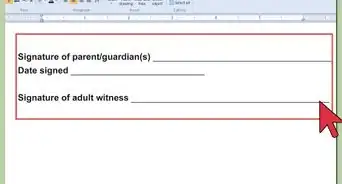This article was co-authored by Luba Lee, FNP-BC, MS. Luba Lee, FNP-BC is a Board-Certified Family Nurse Practitioner (FNP) and educator in Tennessee with over a decade of clinical experience. Luba has certifications in Pediatric Advanced Life Support (PALS), Emergency Medicine, Advanced Cardiac Life Support (ACLS), Team Building, and Critical Care Nursing. She received her Master of Science in Nursing (MSN) from the University of Tennessee in 2006.
There are 10 references cited in this article, which can be found at the bottom of the page.
This article has been viewed 23,962 times.
Under the Health Insurance Portability and Accountability Act (HIPAA), you have the right to access your personal medical records through your medical provider. To access your electronic medical records (EMR), you will need to create a medical records request in writing and submit it to your healthcare provider. Once you receive your EMR, you may want to go through your records to ensure you understand all the information presented in the records.[1]
Steps
Requesting Your Electronic Medical Records
-
1Format your request in letter form. When you compose your request, use the standard letter format, with your personal information listed first (name, address, current date), followed by the name of your healthcare provider or the health care facility that has your medical records.[2]
- Include a salutation, such as “Dear Dr. Jenkins” or “Dear Healthy Living Facility”. Open by noting the purpose of the letter. For example, “The purpose of this letter is to request copies of my medical records.”
- Include your full name, your address, and an explanation of how you want to access your records (e.g., you might ask to get your own paper copy, or to look at the records in your provider’s office).
- If you’d like anyone else to have access to your records, you’ll need to provide the full name of the person or organization. State that you are authorizing them to access your health information.[3]
- Your provider’s office may also provide a release form that you can fill out to request your records.[4]
-
2Specify your treatment dates. Your healthcare provider will likely have many patients and will require specific dates when they treated you so they can locate your medical records.[5]
- For example, you may note: “I was treated at your office [or facility] between [specify dates]. I would like to request copies of the following [or all] health records related to my treatment at your facility.”
Advertisement -
3Identify the type of information you need to access. You can access several different types of information in your medical records, so be specific about this in your request. Your healthcare provider can then provide specific medical records or your complete medical records, based on your needs. You can request the following information:[6]
- A summary of doctor's office visits
- Specific diagnoses for an illness, an infection, a disorder, or a disease
- Doctors' notes
- Laboratory results
- Images, such as X-rays or MRIs
- Information on medication
- Account and billing information
-
4Decide how you want to receive your records. Generally, you will receive your EMR as paper copies. In your request, specify if you would like the receive your EMR in a different manner, such as on a flash drive, via a web link, or on a CD-Rom.[7]
- Keep in mind your healthcare provider may not be able to accommodate how you receive your EMR and may only offer one option for receiving your EMR.
- If you want your records mailed to you, enclose a self-addressed, stamped envelope.
-
5Note the 30-day response period required by HIPAA. According to the Health Insurance Portability and Accountability Act (HIPAA), your healthcare provider must give you access to your medical records within 30 days after they receive your request. If they fail to do this, they must note their failure to you in a formal letter and give you an exact date where you will have access to your medical records.[8]
- If you haven't received your records after 7 days, call your healthcare provider to get an update and see if there is anything you can do to expedite the process.
- If your healthcare provider fails to provider your medical records after the specified date, you can file a complaint against them with the U.S. Department of Health and Human Services' Office of Civil Rights.[9]
-
6Submit the request to your health provider's office. Once you have completed the letter, contact your healthcare provider's office or the health facility that houses your medical records. Submit the letter to the required person(s) so it can be processed.[10]
-
7Be prepared to pay a small fee for access to your records. Under the HIPAA, your healthcare provider cannot charge you a fee for locating your medical records. However, they can charge a reasonable, cost-based fee to cover the cost of giving you access to your medical records.[11]
- For example, you may need to pay a few dollars to get an electronic copy of a record stored on paper or microfilm, to cover the cost of scanning or converting the document to an electronic format.
- Keep in mind your healthcare provider cannot deny you a copy of your medical records due to a failure to pay for services rendered from the healthcare provider, but they can deny you a copy if you don't pay the fee to access your records.
Understanding Your Electronic Medical Records
-
1Ask your doctor about unfamiliar medical terms. Your medical records will likely contain medical terminology that you will not understand. Speak to your healthcare provider and get them to clarify any technical or unfamiliar terms so you can understand your records.[12]
- You can email your healthcare provider or set up an appointment to speak with them in person.
-
2Correct any discrepancies or mistakes with your doctor. Speak to your doctor about any discrepancies or mistakes you notice in your records and get them fixed as soon as possible. This will ensure that your records are correct and up to date.[13]
- Though your health staff will try to update your medical records and maintain accurate information on you, inaccuracies can happen. For example, your doctor may have misunderstood something you said relating to your medical history, leading to an incorrect note in your medical records.
-
3Use your records to understand your health. Examine your records to understand your health and your doctor's treatment recommendations. Your medical records are good resources for staying on top of your health numbers, from your blood pressure numbers to your weight or your blood sugar levels. You can also keep track of how your health numbers have shifted over time.[14]
- Having access to your medical records can also help you to better understand your doctor's health recommendations. Your EMR will contain plans that your doctor has created for your care, allowing you to analyze your doctor's approach to your health.
References
- ↑ https://www.healthit.gov/how-to-get-your-health-record/
- ↑ https://privacyrights.org/resources/sample-letter-request-medical-records
- ↑ https://www.hhs.gov/hipaa/for-individuals/medical-records/index.html
- ↑ https://www.healthit.gov/how-to-get-your-health-record/get-it/
- ↑ https://privacyrights.org/resources/sample-letter-request-medical-records
- ↑ https://www.healthit.gov/how-to-get-your-health-record/whats-in-it/
- ↑ https://www.healthit.gov/how-to-get-your-health-record/get-it/
- ↑ https://www.hhs.gov/hipaa/for-professionals/faq/2050/how-timely-must-a-covered-entity-be/index.html
- ↑ http://www.hhs.gov/ocr/hipaa
- ↑ https://www.hopkinsmedicine.org/patient_care/patients-visitors/patient-rights-records/medical-records.html
- ↑ https://www.hopkinsmedicine.org/patient_care/patients-visitors/patient-rights-records/medical-records.html
- ↑ https://www.healthit.gov/how-to-get-your-health-record/check-it/
- ↑ https://www.healthit.gov/how-to-get-your-health-record/check-it/
- ↑ https://www.healthit.gov/how-to-get-your-health-record/use-it/


































































Medical Disclaimer
The content of this article is not intended to be a substitute for professional medical advice, examination, diagnosis, or treatment. You should always contact your doctor or other qualified healthcare professional before starting, changing, or stopping any kind of health treatment.
Read More...